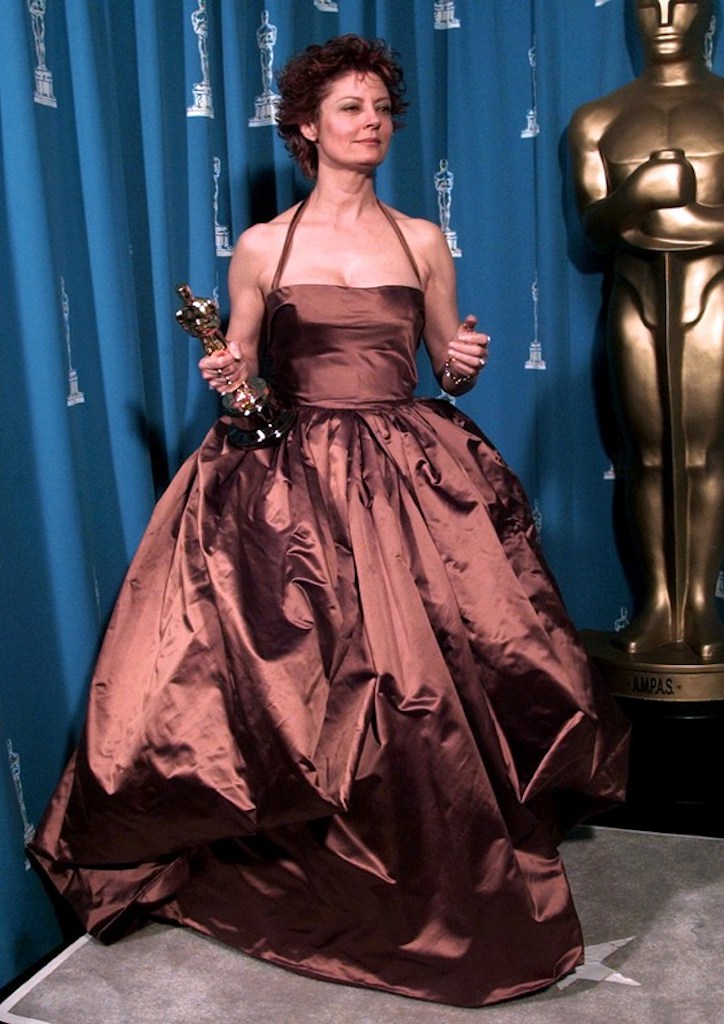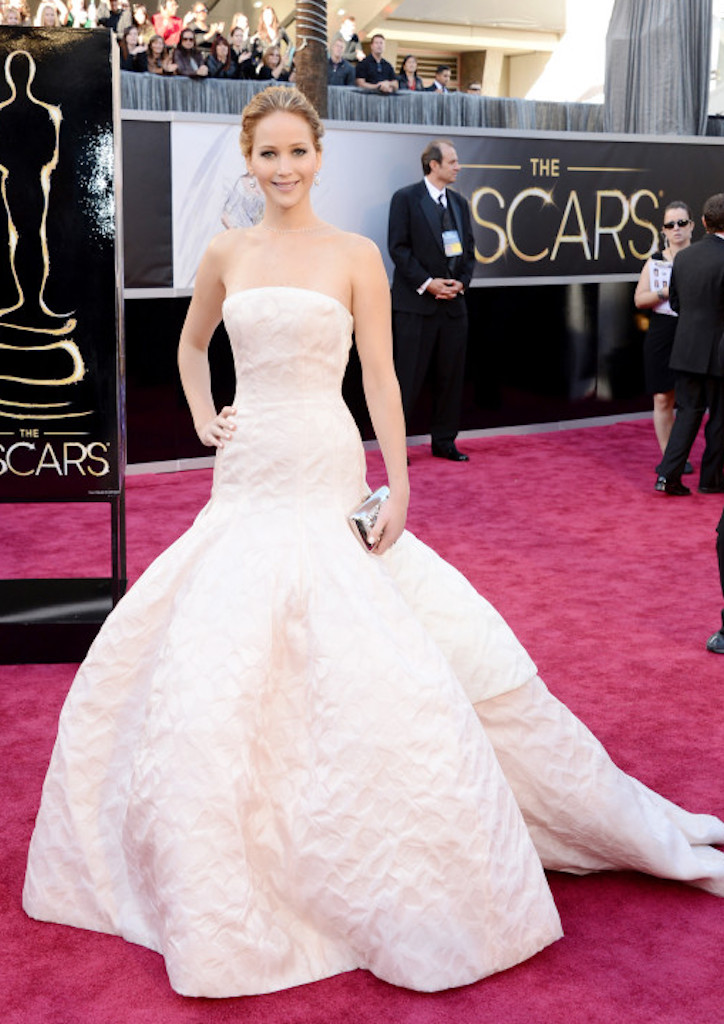The Academy Award’s stage has created many opportunities for great fashion moments. Most of which, come from the Best Actress winners during their respective years. With the 2018 Oscars ceremony just a mere three weeks away, we look back at the iconic gowns of former Best Actress winners and the history behind their choices.


1920s and 1930s: The first Oscar ceremony was held on May 16, 1929 in a private function room at the Hollywood Roosevelt Hotel, with the post-awards party held at the Mayfair Hotel. A ticket to attend the ceremony was at $5 a pop ($71 dollars in today’s dollars). The first actress to win an Academy Award for Best Actress was Janet Gaynor for her portrayal in three films 7th Heaven, Street Angel and the now-iconic Sunrise: A Song of Two Humans. She wore a simple Peter Pan collar dress. The simplicity of the award show back then allowed Gaynor to purchase her dress off-the-rack. By the 1930s, the Oscars gained more popularity, prompting Best Actress winners to begin dressing in glamourous gowns. Some notable dresses that decade include Norma Shearer’s (1930’s winner for The Divorcee) white gown with black fur sleeves (by costume designer Gilbert Adrian), Bette Davis’ black rulle gown with white feathers for the year she won for Jezebel (1938) and Vivien Leigh’s (Gone with the Wind (1939)) Irene Gibbons silk floral dress matched with a white fur coat. These were the first glamourous Oscars.


1940s: As World War II approached, Hollywood actresses decided that glamour was not appropriate wear for the highly-publicized show. The typically gold-plated Oscar statues were also replaced with plaster ones during this era. The Academy set sartorial guidelines for the 1941 Oscars, stating that guests should wear understated clothes in somber palettes, domestically made in the U.S., in respect of the war. Ginger Rogers was the first Best Actress winner of the decade, wearing a grey silk dress. Actress Greer Garson, who won an Oscar for her performances as Mrs. Miniver (1942), a matriarch trying to survive the horrors of World War, wore an understated black two-piece ensemble to show her support for the war overseas.


1950s: By the 1950s, the war in Europe was over and Hollywood was once again, The Dream Factory. In this decade, Oscar fell in love with colorful movie musicals (An American in Paris and Gigi) and big-budget epics (Around the World in 80 Days, Ben-Hur and The Bridge on the River Kwai). The actresses who graced the Academy’s podium to pick up their Best Actress trophies followed suit and dressed in couture creations meant only for movie stars. Audrey Hepburn made her first appearance as a Hollywood heavyweight winning an Oscar for Roman Holiday (1953) in a Hubert de Givenchy gown. A year after, the future Princess of Monaco, Grace Kelly looked stunning in an Edith Head ice blue creation for her victory lap for The Country Girl (1954).


1960s: Elizabeth Taylor kicked-off the glamourous 1960s with her performance in Butterfield 8 (1960) in which she won the Oscar for Best Actress. A huge fan of Dior, it was only fitting she wore a full-skirted floral ensemble by Dior’s then-creative director Marc Bohan. Julie Christie stunned the world with her gorgeous performance in Darling (1965). For her win, she was dressed in an all-gold lamé jumpsuit that she made herself. Everybody’s favorite diva Barbra Streisand wore a Arnold Scasi sheer blouse and trousers (finished off with sequin) to accept her Oscar for Funny Girl (1968).


1970s: By the height of the Vietnam War, Oscar attendees stayed off haute couture gowns to show their solidarity with the war in the distant East. For her 1972 win for the movie musical Cabaret, Liza Minnelli chose to wear a simple, cannery yellow gown by her friend Halston. Diane Keaton, who won an Oscar for Annie Hall (1977), began a style revolution because of her menswear-inspired outfits in the film. She repeated her signature look on the Oscar stage wearing a large blazer, scarf, and polo shirt to match her pleated skirt.


1980s: Glamour was back (for better or for worse) in the 1980s. Movie star Sissy Spacek wore a black jumpsuit to kick-off the decade the year she won Best Actress for Coal Miner’s Daughter (1980). Meryl Streep won the second of her three Oscars in 1982 for Sophie’s Choice. She wore a Christian Leigh gold beaded gown. One of the most famous Oscar dresses appeared in the 1987 ceremony. Pop star turned serious actress Cher wore a gown by her friend Bob Mackie, whom she had met backstage at The Carol Burnett Show in the 1960s. Cher’s gown (well—lack of gown) was made of sheer and only covered certain “parts” of her body. As insane as the dress looks now in retrospect—we love it! So appropriate for the megastar that is Cher.


1990s: As Fashion Police Joan Rivers began asking stars “who are you wearing on the Red Carpet?,” the Oscars were never the same again. Stars became even more watchful of the labels they donned on Oscar night. Fashion houses were excited to dress Hollywood’s It-Girls, hoping for the chance to dress one of the evening’s eventual winners, in which much publicity was assured. Names such as Valentino, Giorgio Armani, and Chanel began taking the Red Carpet. Holly Hunter, who won for 1993’s The Piano, sported a custom-made backless Vera Wang outfit during her victory. Susan Sarandon’s Dolce & Gabbana copper ball gowns was later featured in a exhibit at the Costume Institute at New York’s Metropolitan Museum of Art. That year, she took home the golden man for her role in Dead Man Walking (1995). Lastly, who can forget Gwyneth Paltrow’s pink dress? Often cited as one of Oscar history’s most memorable fashion moments, Paltrow wore her Ralph Lauren gown the night she took home the gold for Shakespeare in Live (1998).



2000s and 2010s: Present day Oscar Best Actress dresses are couture gold. Each year, fashion pundits (some without any movie knowledge) stake out their favorite stars just to see their favorite rep carpet looks. There were many notable gowns worn by actresses during the early days of the new millennium. Julia Roberts wore a black-and-white vintage Valentine piece when she won for 2000’s Erin Brockovich. Halle Berry’s historic win for 2001’s Monster’s Ball saw her on the Oscar podium wearing an Ellie Saab sheer gown with embroidered flower details. The Hours’ (2002) Nicole Kidman stunned the world (and officially began her career as a fashion idol) when she wore a midnight blue Jean Paul Gaultier gown. Charlize Theron in a golden beaded piece by Gucci is flawless. She won that year for Monster (2003). Marion Cotillard’s awards run for La Vie en Rose (2007) ended with a surprise Oscar win in a custom-designed Jean Paul Gaultier gown.
In the new decade, who can forget Jennifer Lawrence’s stumble as she walked up the stage to accept her statue for Silver Linings Playbook (2012)? She wore a beautiful, voluminous Dior gown. Cate Blanchett matched her Chopard jewelry with a custom-made Armani Prive embellished gown the night she wore for Blue Jasmine.
With the recent Time’s Up Movement taking Hollywood by storm, we’re excited for this year’s ceremony, and see how our favorite stars will support the cause on the Red Carpet. For the recent Golden Globes and BAFTA, Hollywood dressed in all-black ensembles to show their solidarity against sexual harassment.
—
By Chino R. Hernandez





